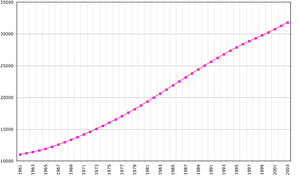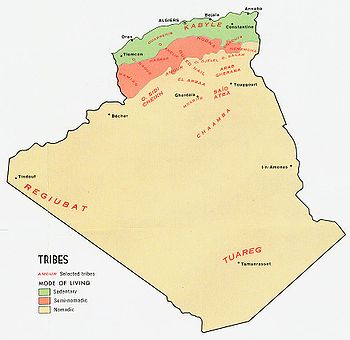- Demographics of Algeria
-
This article is about the demographic features of the population of Algeria, including population density, ethnicity, education level, health of the populace, economic status, religious affiliations and other aspects of the population.
Ninety-one percent of the Algerian population lives along the Mediterranean coast on 12% of the country's total land mass. Forty-five percent of the population is urban, and urbanization continues, despite government efforts to discourage migration to the cities. Currently, 24,182,736 Algerians live in urban area, about 1.5 million nomads live in the Saharan area.
99% of the population is classified ethnically as Arab-Berber[1] and religiously as Sunni Muslim 96%, the few non-Sunni Muslims are mainly Ibadis 1.3% from the M'Zab valley (See Islam in Algeria). A mostly foreign Roman Catholic community also about Christians especially Protestant evangelic and almost 500 Jewish, most of them live in Bejaia. The Jewish community of Algeria, which once constituted 2% of the total population, has substantially decreased due to emigration, mostly to France and Israel.
Algeria's educational system has grown rapidly since 1962; in the last 12 years, attendance has doubled to more than 5 million students. Education is free and compulsory to age 16. Despite government allocation of substantial educational resources, population pressures and a serious shortage of teachers have severely strained the system, as have terrorist attacks against the educational infrastructure during the 1990s. Modest numbers of Algerian students study abroad, primarily in Europe and Canada. In 2000, the government launched a major review of the country's educational system.
Housing and medicine continue to be pressing problems in Algeria. Failing infrastructure and the continued influx of people from rural to urban areas has overtaxed both systems. According to the UNDP, Algeria has one of the world's highest per housing unit occupancy rates for housing, and government officials have publicly stated that the country has an immediate shortfall of 1.5 million housing units.
CIA World Factbook demographic statistics
The following demographic statistics are from the CIA World Factbook, unless otherwise indicated.[2]
Population
- 35,586,184 ( 2011 est.)
Age structure
- 0–14 years: 25.4% (male 4,436,591/female 4,259,728)
- 15–64 years: 69.5% (male 11,976,965/female 11,777,618)
- 65 years and over: 5.1% (male 798,576/female 928,709) (2010 est.)
Median age
- total: 27.1 years
- male: 26.9 years
- female: 27.3 years (2010 est.)
Population growth rate
- 2.03% (2010)
Birth rate
- 16.71 births/1,000 population (2010 est.)
Death rate
- 4.66 deaths/1,000 population (2010 est.)
Net migration rate
- -0.28 migrant(s)/1,000 population (2010 est.)
Urbanization
- Urban population: 65% of total population (2008)
- Rate of urbanization: 2.5 annual rate of change (2005-2010 est/)
Sex ratio
- At birth: 1.05 male(s)/female
- Under 15 years: 1.04 male(s)/female
- 15–64 years: 1.02 male(s)/female
- 65 years and over: 0.86 male(s)/female
- Total population: 1.01 male(s)/female (2009 est.)
Infant mortality rate
- Total: 27.73 deaths/1,000 live births
- country comparison to the world: 80
- Male: 30.86 deaths/1,000 live births
- Female: 24.45 deaths/1,000 live births (2009 est.)
Life expectancy at birth
- Total population: 74.26 years
- Male: 72.57 years
- Female: 76.04 years (2010 est.)
Total fertility rate
- 1.76 children born/woman (2010 est.)
Nationality
- Noun: Algerian(s)
- Adjective: Algerian
HIV/AIDS
- Adult prevalence rate: 0.1% ; note - no country specific models provided (2001 est.)
- People living with HIV/AIDS: 21,000 (2007 est.)
- Deaths: less than 1000 (2007 est.)
Major infectious diseases
- Degree of risk: intermediate
- Food or waterborne diseases: bacterial diarrhea, hepatitis A, and typhoid fever
- Vectorborne disease: cutaneous leishmaniasis is a high risk in some locations (2005)
Ethnic groups
- Arab-Berbers 99%,[3] European less than 1%
In a very recent study (2008) done in northwestern Algeria (Oran area),[4] the most common haplogroups observed in the Algerian population (n=102) were :
- E1b1b (50.9 %)
- E1b1b1b (M81) (45.1%) very common in northwest Africa and also found, with much lower frequencies compared to those observed in northwest Africa, in Turkey, the near East, the Balkans, southern Europe and in Iberia.
- E1b1b1a (M78) (5.8%) widely distributed in North Africa, the Horn of Africa, West Asia up to Southern Asia, and all of Europe (with distribution peak centered in parts of the Balkans and Italy and declining frequencies in western, central, and northeastern Europe).
- J (35.0 %)[5]
- R1 (12.8 %)
- R1b (M269) (10.8%) typically found in Eurasia.
- R1a (M17) (1%) typically associated with the area from Central and Eastern Europe to South Asia
- R1 (M173) (1%) typically found in Central and South Asia
- E1b1a (M2) (7.8%) typically Associated with West Africa
- Others
- Q (M242) (1%) typically associated with East, South, North and part of West Asia, and the Native American populations.
Y-Dna Haplogroup frequencies in coastal Algeria
Population Nb E1a E1b1a E1b1b1a E1b1b1b E1b1b1c F K J1 J2 R1a R1b Q Study 1 Oran 102 0 7.85% 5.90% 45.10% 0 0 0 22.50% 4.90% 1% 11.80% 1% Robino et al. (2008)[6] 2 Algiers 35 2.85% 0 11.40% 42.85% 0 11.80% 2.85% 22.85% 5.70% 0 0 0 Arredi et al. (2004)[7] 3 Tizi Ouzou 19 0 0 0 47.35% 10.50% 10.50% 0 15.80% 0 0 15.80% 0 Arredi et al. (2004) Total 156 0.65% 5.10% 6.40% 44.90% 1.30% 9.58% 0.65% 21.80% 4.50% 0.65% 9.60% 0.65% In a recent genetic study by Semino et al. (2004), Algerian Arabs and Berbers were found to have more genetic similarities than was once believed.[8] This led scientists to conclude that the North African population was mainly Berber in origin and that the population had been 'Arabised', by the migration of Near-Eastener people.
The Haplogroup J1, marker of the Semitic population is found at 35% in Algeria , which is one of the most common haplogroup of the country along with E1b1b (Berber marker).
Recent studies on the common J1 Y chromosome suggest it arrived over ten thousand years ago in North Africa, and M81/E3b2 is a Y chromosome specific to North African ancestry, dating to the Neolithic. A thorough study by Arredi et al. (2004) which analyzed populations from Algeria concludes that the North African pattern of Y-chromosomal variation (including both E3b2 and J haplogroups is largely of Neolithic origin, which suggests that the Neolithic transition in this part of the world was accompanied by demic diffusion of Afro-Asiatic–speaking pastoralists from the Middle East. This Neolithic origin was later confirmed by Myles et al. (2005) which suggest that "contemporary Berber populations possess the genetic signature of a past migration of pastoralists from the Middle East",[9]
Religions
- Sunni Islam 99% (state religion), Christian and Jewish 1%
Languages
Main article: Languages of AlgeriaLiteracy
Definition: Age 15 and over can read and write
- Total population: 69.9%
- Male: 79.6%
- Female: 60.1% (2002 est.)
Education expenditures
- 5.1% of GDP (1999)
References
- ^ http://www.familytreedna.com/public/Y-DNA_J/default.aspx
- ^ CIA - The World Factbook -- Algeria
- ^ Analysis of Y-chromosomal SNP haplogroups and STR haplotypes in an Algerian population sample
- ^ Analysis of Y-chromosomal SNP haplogroups and STR haplotypes in an Algerian population sample
- ^ http://www.familytreedna.com/public/Y-DNA_J/
- ^ Robino et al. (2008), Analysis of Y-chromosomal SNP haplogroups and STR haplotypes in an Algerian population sample
- ^ Arredi et al. (2004),A Predominantly Neolithic Origin for Y-Chromosomal DNA Variation in North Africa
- ^ Semino et al. (2004), Origin, Diffusion, and Differentiation of Y-Chromosome Haplogroups E and J
- ^ although later papers have suggested that this date could have been as longas ten thousand years ago, with the transition from the Oranian to the Capsian culture in North Africa. SpringerLink - Journal Article
External links
 This article incorporates public domain material from the CIA World Factbook document "2009 edition". and the As of 2003[update] U.S. Department of State website.
This article incorporates public domain material from the CIA World Factbook document "2009 edition". and the As of 2003[update] U.S. Department of State website.Demographics of Africa Sovereign
states- Algeria
- Angola
- Benin
- Botswana
- Burkina Faso
- Burundi
- Cameroon
- Cape Verde
- Central African Republic
- Chad
- Comoros
- Democratic Republic of the Congo
- Republic of the Congo
- Côte d'Ivoire (Ivory Coast)
- Djibouti
- Egypt
- Equatorial Guinea
- Eritrea
- Ethiopia
- Gabon
- The Gambia
- Ghana
- Guinea
- Guinea-Bissau
- Kenya
- Lesotho
- Liberia
- Libya
- Madagascar
- Malawi
- Mali
- Mauritania
- Mauritius
- Morocco
- Mozambique
- Namibia
- Niger
- Nigeria
- Rwanda
- São Tomé and Príncipe
- Senegal
- Seychelles
- Sierra Leone
- Somalia
- South Africa
- South Sudan
- Sudan
- Swaziland
- Tanzania
- Togo
- Tunisia
- Uganda
- Zambia
- Zimbabwe
States with limited
recognition- Sahrawi Arab Democratic Republic
- Somaliland
Dependencies and
other territories- Canary Islands / Ceuta / Melilla / Plazas de soberanía (Spain)
- Madeira (Portugal)
- Mayotte / Réunion (France)
- Saint Helena / Ascension Island / Tristan da Cunha (United Kingdom)
- Western Sahara
Categories:
Wikimedia Foundation. 2010.


